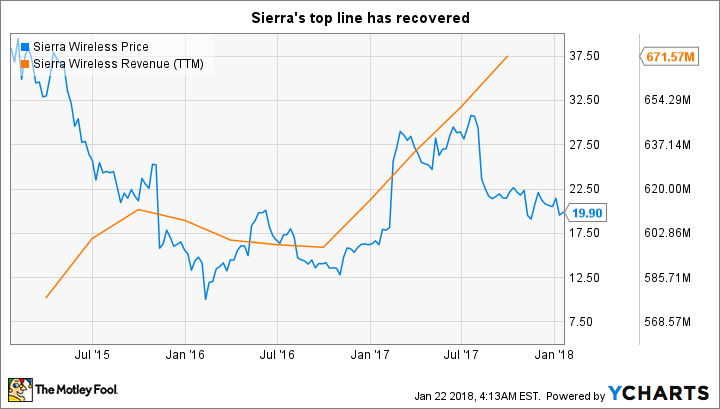Why Sierra Wireless Could Be a Top Stock Pick for 2018
For Sierra Wireless (NASDAQ: SWIR), 2017 turned out to be a mixed bag. The Internet of Things (IoT) specialist had a terrific start to the year but tepid fourth-quarter guidance calling for a drop in the earnings, and not so attractive year-over-year revenue growth of 8%, tempered that growth. However, investors shouldn't forget that Sierra operates in a market that's set for rapid growth in the long run.
Cisco estimates that sales of machine-to-machine (M2M) connectivity modules, which Sierra specializes in, will grow at a compound annual rate of 49% through 2021. So investors shouldn't panic as Sierra could pick up speed starting this year for several reasons. Let me explain.

Image Source: Getty Images.
Top-line growth is gaining momentum
Sierra Wireless had a tough time on the stock market in 2016 because of a slowdown in the original equipment manufacturer (OEM) solutions business, which supplies almost 80% of its revenue. The OEM business was plagued by weak customer demand, but management was confident that the softness would be temporary.
So the company's comeback in 2017 wasn't surprising, as demand from OEM customers improved thanks to the ramp-up of new programs across segments like automobiles, networking, and energy, among others. More specifically, Sierra's OEM solutions revenue increased just over 9% during the first three quarters of 2017, leading to impressive top-line growth as shown by the chart above.
The OEM solutions business is on track to get even better thanks to Sierra's contract with Volkswagen, which will start deploying Sierra's connectivity modules in its cars this year. The two companies signed the contract last year, with Volkswagen committing to deploy Sierra's integrated 4G technology based on the AirPrime modules to enable high-speed connectivity in its cars.
The press release stated that the "integrated 4G technology will reach the market beginning in 2018 in several Volkswagen models worldwide." More importantly, Sierra has won a total of three contracts at Volkswagen that will see it supplying high-end connectivity modules and budget 4G modules, and also enable connectivity in the automaker's electric vehicle program.
Sierra should find its way into a substantial number of Volkswagen models starting this year, and this could boost its OEM solutions business as the German automaker tops the list in global car sales with 10.7 million sold last year. Analysts forecast that Sierra's sales could grow 17.3% in 2018 after a jump of 11.4% in the previous year.
LPWA module sales will gain traction
Sierra Wireless' low-power wide-area (LPWA) network modules should start contributing to its top-line growth in 2018. These modules are the key to enabling IoT connectivity because their low power consumption allows them to operate for years, enabling telecom carriers to connect devices within short ranges (to enable smart cities), and also monitor IoT sensor data, in an inexpensive manner.
Sierra's LPWA module was already in use in pilot programs with telecom carriers in North America during the third quarter of 2017. Now, T-Mobile has certified Sierra's LPWA module to enable large-scale IoT deployments across its network. The telecom carrier's IoT network is expected to be operational nationwide by the end of the year, and this could boost demand for Sierra's LPWA modules.
Sierra can score more such wins with telecom carriers because its LPWA modules can connect to multiple networks, switching between 2G, 3G, or 4G connectivity to ensure uninterrupted data transmission. As a result, telecom carriers won't have to use different modules for different data connections, allowing them to save costs.
Sierra's move into LPWA modules could ensure long-term growth. Machine Research forecasts 3 billion LPWA connections will be added through 2025, pushing the market's revenue to $19.5 billion in 2025 from $522 million in 2016.
Attractive valuation
Sierra's decline in the stock market over the past six months has made it cheap. The stock trades at 26.8 times last year's earnings, lower than the 35.3 industry average. Additionally, a forward earnings multiple of 17.9 indicates that bottom-line growth is on the way for Sierra.
Investors shouldn't miss the opportunity in Sierra Wireless as the weakness seen in the second half of 2017 shouldn't last long, given the catalysts discussed above.
More From The Motley Fool
Harsh Chauhan has no position in any of the stocks mentioned. The Motley Fool owns shares of and recommends Sierra Wireless. The Motley Fool recommends Cisco Systems and T-Mobile US. The Motley Fool has a disclosure policy.

 Yahoo Finance
Yahoo Finance 
